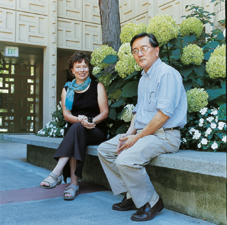What inspired Peggy Pizzo and Tenzin Tethong to invite the Dalai Lama — the religious and political leader of the Tibetan people — to Stanford?
Angela Wyant |
|
 |
|
By ROSANNE SPECTOR
The story begins with a car crash. It was in Boston on an afternoon in 1998 and Peggy Pizzo’s car was hit from behind. The jolt caused a small amount of whiplash and, oddly, deprived her of her voice for months. Meanwhile, repetitive stress syndrome had made writing and using a keyboard inadvisable for Pizzo, who at the time was a scholar of early childhood education and public policy at Harvard.
A disaster, yes. But not without a bright spot.
“It seemed like a good time for reading,” says Pizzo.
A few of the books on her recuperation reading list set in motion the Dalai Lama’s planned visit to Stanford on Nov. 4 and 5, 2005.
A Quaker (though, Pizzo adds, “not a very good one”), she had long desired to study the Buddhist monk’s teachings on nonviolence. She dug into texts describing his philosophy and teachings. What she read was stimulating. But beyond that, “it was helpful personally,” she says. Learning to shift perspective on challenging situations and see them in a different light, as the Dalai Lama advised, was useful. Of interest also was the idea that training the mind to achieve calm in many different circumstances is a route to happiness — and that happiness is the goal of life.
Pizzo’s voice eventually returned. Not long after, her husband, Harvard’s chairman of pediatrics, Philip Pizzo, MD, accepted the job of leading Stanford’s medical school. The family moved west and began adjusting to California’s unfamiliar ways. “The informality and openness are different from what we’re used to on the East Coast,” she says.
The Dalai Lama at StanfordThe 14th Dalai Lama Tenzin Gyatso will visit Stanford on Nov. 4 and 5, 2005. The visit will include a symposium on neuroscience, a talk on meditation and a conversation on nonviolent conflict resolution. For information about tickets and Web casts, call (650) 723-4441 or go to http://dalailama.stanford.edu. |
|||||
But a summer 2002 Continuing Studies course on the Dalai Lama promised a thread of continuity. Peggy Pizzo joined the class, became further fascinated with the philosophy and personal history of the Dalai Lama and often stayed afterward to speak with the teacher, human-rights advocate and former member of Tibet’s government in exile, Tenzin Tethong.
During one of those talks, Pizzo asked Tethong if he thought it might be possible to interest the Dalai Lama in coming to Stanford. Fresh in her mind was a campus rally for peace in Israel that spring, marked by angry speeches from many participants.
“When I asked Tenzin if he thought His Holiness would come to speak to the students about nonviolent expression, his whole face lit up,” she says. “I was encouraged.”
Pizzo soon realized that Stanford had another draw for the monk: neuroscientists. He’s a major science geek, with a special thing for the latest brain research. Since 1987 he has participated in a series of symposia bringing together Western scientists and Buddhist scholars, organized by the nonprofit Mind and Life Institute, based in Louisville, Colo.
So after gaining support for her idea from Stanford’s dean of religious life Rev. Scotty McLennan and his wife Ellen, not to mention her own husband, she pulled together an information packet about Stanford’s neuroscientists and sent it to Tethong’s home. He mailed it with an invitation to the Dalai Lama’s office in Dharamsala, India.
A letter came back with word that the Dalai Lama was considering the request. But the wait for a visit to be scheduled would likely be years, Tethong told Pizzo. So she was floored when a few months later Tethong gave her the news: “He told me that His Holiness had just agreed to come and talk with the students, meet with the neuroscientists and he also proposed a Mind and Life Institute symposium to be held here. I was euphoric.”
And happiness, after all (per the Dalai Lama), is what it’s all about.
Comments? Contact Stanford Medicine at

